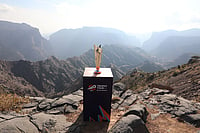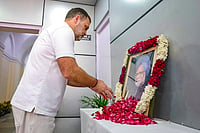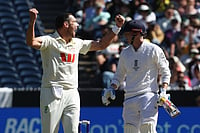The adjectives are piling up. "The maverick set on changing the face of the game" (BBC) has been reduced to a "maverick" (Daily Mail). The "autocratic yet respectful leader of Indian cricket" (The Guardian) has enhanced his reputation as "something of loose cannon" (The Times). "Give a man a big job and he will show you how small he can be. It hasn’t taken Dalmiya very long to reveal his complete unsuitability for any post within the cricket world," concludes The Daily Telegraph.
Just why does the world find it so easy to slam the author of the still-in-the-pipeline How to Make Enemies and Influence Events?
Dalmiya, 62, is England’s current pet hate because he wants to cut the number of Tests to be played by India next summer from four to three (estimated loss: £5 million). But the mutual antipathy goes back a long way. The upper lip stiffened and then froze as Dalmiya & Co turned the low-profile, tradition-bound English sport into a high-jinks, break-every-rule marketers’ mecca. With the 1996 World Cup establishing South Asia as cricket’s new economic powerhouse, Dalmiya set about using that power ruthlessly. First to instal himself as ICC president and then to ensure that the subcontinent was at the centre of the cricket world.
This immediately rubbed the West Indies the wrong way because Sir Clyde Walcott, who was firmly ensconced, had the support of two-thirds of the Test-playing nations and was looking for a second term. But Dalmiya, with advice from a Queen’s Counsel (QC), set the cat among the pigeons by claiming a simple majority with the help of ICC associate members whom he had helped during the World Cup chase. A compromise ensued. ICC would have presidents by rotation; Dalmiya, naturally, was the first.
But a host of moves by Dalmiya made the "traditional powers" wary of him:
- He proposed measures to eliminate the "draw" from Test matches to make them more attractive for spectators and viewers.
- He decided to take cricket beyond the Commonwealth by proposing a tournament in Disneyland, among other places.
- He hurriedly gave Test status to Bangladesh, leading to accusations of vested interests.
- Bangladesh displaced Sharjah as an offshore centre as soon as tobacco advertising was banned by the desert kingdom.
- And as the match-fixing controversy raged, Dalmiya’s name began getting mentioned in the award of lucrative TV contracts.
After he relinquished his ICC position, Dalmiya set up the Asian Cricket Foundation and made threatening noises that hinted at splitting the ICC; the Mike Denness imbroglio only confirms the worst fears. As the Australian premier backs the ICC move to derecognise the third Test, The Guardian seems prescient: "Dalmiya is genuinely concerned that the traditional powers of world cricket, especially England but Australia, too, have been on a revenge mission since his mould-breaking term of office as ICC chief ended."
Although the initial rumours of South Africa instigating the referee in a tit-for-tat for Hansie Cronje have died down, the fact that the Proteas have stood by India reinforces Dalmiya’s reputation as a man who could sell refrigerators to Eskimos in winter. Admittedly, India was the first country SA toured after the end of apartheid but the financial implications for the 2003 World Cup without India clearly played a big part.
The mutinous stand-off presents the ICC with the biggest threat to the international game since the Kerry Packer crisis 24 years ago. But the Calcutta builder on a demolition drive probably doesn’t care. If only Indian players, rather than the board president, had more of the killer instinct, Michael Henderson would have never asked in The Daily Telegraph: "Just who does Dalmiya think he is?"






















